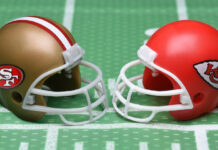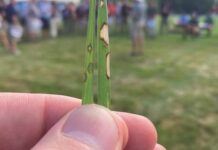How often do you mow customer lawns during the spring and fall compared to the summer? What type of equipment do you use? What heights are the blades? If any of the lawns you service are poor shape, and you’ve been watering and fertilizing regularly, examine the mowing practices being used.
Following is guidance offered from three university extensions around the United States. As these are specific to the region, keep that in mind. (If you have mowing best practices to share with fellow readers, send an e-mail with a brief overview to Turf at acosgrove@groupc.com.)

Colorado State University Extension provides this insight for turf in that region (Lawn Care, Fact Sheet No. 7.202):
“The two most important facets of mowing are mowing height and frequency. The minimum height for any lawn is 2″. The preferred mowing height for all Colorado species is 2.5″ to 3″. Mowing to less than 2″ can result in decreased drought and heat tolerance and higher incidence of insects, diseases, and weeds.
Mow the turf often enough so no more than one-third of the grass height is removed at any single mowing. If your mowing height is 2″, mow the grass when it is 3″ tall. You may have to mow a bluegrass or fescue lawn every three to four days during the spring when it is actively growing but only once every seven to 10 days when growth is slowed by heat, drought, or cold. Buffalograss lawns may require mowing once every 10 to 20 days, depending on how much they are watered.
If weather or another factor prevents mowing at the proper time, raise the height of the mower temporarily to avoid cutting too much at one time. Cut the grass again a few days later at the normal mowing height.
Let grass clippings fall back onto the lawn, unless they are used for composting or mulching elsewhere in the landscape. Grass clippings decompose quickly and provide a source of recycled nutrients and organic matter for the lawn.
Grass clippings do not contribute to thatch accumulation. If herbicides are applied to the lawn, do not use clippings in the vegetable or flower gardens. Keep them on the lawn.”
The University of Illinois Extension provides these tips (Circular 1009):
“Mowing has a major impact on lawn appearance and health, yet is often overlooked in terms of importance. One very common mistake is mowing lawns too short. For most lawns, a mowing height between 2½” to 3″ is suggested; the upper range is best for summer. Lawns mowed at higher heights tend to have deeper roots, less weed problems, and look much better. Mowing too close invites problems such as weed invasions. Simply raising the mowing height can have a major impact on the quality of many home lawns. A height of 2″ is fine when grasses are rapidly growing, but the height should be raised as growth slows, stress increases, and when the lawn is in shade.
Lawns should be mowed according to the rate of grass growth; remember not to remove more than one-third of the grass leaf in any one cutting. Mowing as the lawn needs it is essential. In the spring, this will likely mean more than once a week.
Another issue related to mowing is whether clippings should be collected. As long as the lawn is mowed on an as needed basis and the one-third rule is followed, clippings will readily filter back down into the lawn, and need not to be collected. The clippings readily decompose (they contain 75-80% water) and do not cause thatch. Clippings also recycle nutrients, in particular nitrogen, so less fertilizer is needed.”
And, further south, the University of Georgia Extension provides this overview of grasscycling (Circular 1031):
“Grasscycling is the natural recycling of grass clippings by leaving them on the lawn after mowing. Grasscycling saves time, effort and, when done properly, is good for the environment and health of the grass.”
Saves Time. A study in Texas, the “Don’t Bag It Lawn Care Plan,” found that grasscycling required one extra mowing per month, but that mowing time was reduced by 35 minutes at each mowing. After six months of grasscycling, homeowners who took part in the study reduced their time spent doing yard work by an average of seven hours.
Does Not Lead to Thatch. It has been a commonly held belief that grass clippings were a major cause of thatch, and that removing clippings would slow thatch development. However, research has determined that thatch buildup is caused by grass stems, shoots and roots—not clippings.
Returns Nutrients to the Soil. Homeowners who practice grasscycling aid soil fertility because grass clippings rapidly decompose, returning nitrogen and other valuable nutrients to the soil. These nutrients can then be absorbed by the turfgrass. One study suggests this process takes less than one week. Depending on the grass variety, soil conditions and type of nitrogen applied as fertilizer, the amount of nitrogen recovered from grasscycling could be as much as 20%.
Requires Proper Mowing. Proper mowing is the key to successful grasscycling. Proper mowing includes:
- Cutting the grass at the recommended height.
- Maintaining a sharp mower blade.
- Mowing often enough to remove no more than one-third of the plant height.
For example, if tall fescue is maintained at 3″, it should be mowed when it reaches 4″. If the grass becomes too tall between mowings, raise the mowing height for the first cutting and then gradually lower it with subsequent mowings until the proper height is reached. During stress periods, such as summer drought, raise the mowing height, but continue mowing regularly enough to avoid excess leaf removal.
Sometimes clippings do not fall into the canopy but remain on top of the lawn. These should be distributed to reduce their concentration and allow them to more easily move into the canopy. Consider scattering the clippings with a hand rake or blower.
 Cosgrove is Editor-in-Chief of Turf.
Cosgrove is Editor-in-Chief of Turf.
Do you have a comment? Share your thoughts in the Comments section below, or send an e-mail to the editor acosgrove@groupc.com.)











![[VIDEO] Dickies®: Discover Workwear That’s Anything But Uniform](https://turfmagazine.com/wp-content/uploads/2023/06/1647663814-4b1a2a7742790a9b1e97a3b963477850192e1d6a9dfba9b07214a77bae25d6e3-d-218x150.jpg)






























![[VIDEO] Dickies®: Discover Workwear That’s Anything But Uniform](https://turfmagazine.com/wp-content/uploads/2023/06/1647663814-4b1a2a7742790a9b1e97a3b963477850192e1d6a9dfba9b07214a77bae25d6e3-d-324x160.jpg)